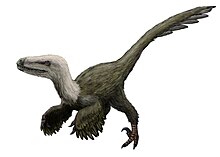| Kansaignathus | |
|---|---|

| |
| Life reconstruction of Kansaignathus | |
| Scientific classification | |
| Domain: | Eukaryota |
| Kingdom: | Animalia |
| Phylum: | Chordata |
| Clade: | Dinosauria |
| Clade: | Saurischia |
| Clade: | Theropoda |
| Family: | †Dromaeosauridae |
| Clade: | †Eudromaeosauria |
| Subfamily: | †Velociraptorinae |
| Genus: | †Kansaignathus Averianov & Lopatin, 2021 |
| Type species | |
| †Kansaignathus sogdianus Averianov & Lopatin, 2021
| |
Kansaignathus (/ˌkɛnsɑːiˈnɛiθəs/) is an extinct genus of dromaeosaurid theropod from the Late Cretaceous Yalovach Formation (or Ialovachsk Formation) of Tajikistan. The genus contains only one species, the type species, K. sogdianus. The generic name of Kansaignathus comes from near the town of Konsoy ("Kansai" in Russian) where it was discovered and the Greek word "gnathos" meaning "jaw". The specific epithet "sogdianus" is derived from the historical region of Sogdiana, which was an ancient name for the Fergana Valley region where the fossil was discovered.[2] Kansaignathus is known from a single right dentary bone[2] and a few post-cranial bone fragments.[3] It was the first, and so far the only, dinosaur from Tajikistan to be described and named.[2]
- ^ Matthew Carrano (2006). "Kansai, FKA-7a (Cretaceous of Tajikistan), Also known as Kansay". The Paleobiology Database.
When: Yalovach Formation, Early/Lower Santonian (85.8 - 83.5 Ma), Upper part of the Yalovach Formation
- ^ a b c Averianov, A. O.; Lopatin, A. V. (2021). "A New Theropod Dinosaur (Theropoda, Dromaeosauridae) from the Late Cretaceous of Tajikistan". Doklady Earth Sciences. 499 (1): 570–574. Bibcode:2021DokES.499..570A. doi:10.1134/S1028334X21070047. S2CID 239088573..
- ^ Cite error: The named reference
newwas invoked but never defined (see the help page).